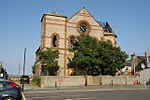Portland Walk Shopping Centre

Portland Walk is a shopping centre in Barrow-in-Furness, Cumbria, England. Constructed in 1998 on the site of the former Forshaw Street, it was designed as a modern extension to Dalton Road; Barrow's principal shopping district. Barrow Indoor Market is also located adjacent to the southern entrance of the centre. Portland Walk has a total retail floor area of around 200,000 sq ft (19,000 m2) and contains over 30 stores and services. The complex is entirely open-air, however, there has been unsuccessful proposals to cover it with a roof. A 500-space multi-storey car park provides direct access to the centre. National retailers with a presence in Portland Walk are Boots, British Heart Foundation, Card Factory, Clarks, Clintons Cards, EE, Game, Goldsmiths, JD Sports New Look and Sports Direct.
Excerpt from the Wikipedia article Portland Walk Shopping Centre (License: CC BY-SA 3.0, Authors, Images).Portland Walk Shopping Centre
Portland Walk,
Geographical coordinates (GPS) Address Nearby Places Show on map
Geographical coordinates (GPS)
| Latitude | Longitude |
|---|---|
| N 54.1124 ° | E -3.2268 ° |
Address
Portland Walk 46-48
LA14 1DB , Hindpool
England, United Kingdom
Open on Google Maps





